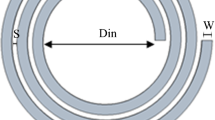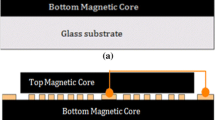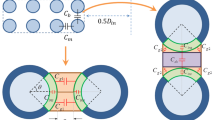Abstract
The Dielectric Losses associated with inductors play more considerable role at higher frequencies. Parasitic capacity determines the magnitude of these losses. The permeability is one of the factors that affect self-inductance of a solenoid directly. Change of medium from free space to any other element like iron or plastic may change the behavior of solenoid. Human hair is primarily composed of keratin. Keratin is considered as a good insulator. However an electric charge gained by the hairs due to friction and this phenomenon is called tribo-electric effect. It gives hair an ability to become charged with static electricity. The scenario tested with coils is wrapped around human hairs and the air between them as a medium. It is hypothesized that replacement of iron by human hair will vary the self-induction. The reference or test validation platform for the experiment was an air and iron core inductor. The reason behind this choice was its wide use in various applications like power supplies, metal detectors, car ignition coils and even in high speed digital systems. The observed values of induced e.m.f for the scenario are used to analyze the deviation in self-Inductance phenomenon. The theoretical model for the air and iron core solenoid is also compared with the resulting values to calculate and reaffirm the permeability values of the human hair especially for South Asian ethnic region.




Similar content being viewed by others
References
Huang, T. H. & Wang, J. -L. (2007) New frequency plan and reconfigurable 6.6/7.128 GHz CMOS quadrature VCO for MB-OFDM UWB application. IEEE MTT-S Int. Microwave Symp. Dig., pp. 843–846.
Nieuwoudt, A., & Massoud, Y. Optimizing the design of tunable spiral inductors for on-chip wireless applications. In M. Demirkan, P. Bruss, & R. R. Spencer (Eds.), Proceedings IEEE Wireless and Microwave Technology. Design of Wide Tuning-Range CMOS.
VCOs using switched coupled-inductors”, IEEE Journal of Solid-State Circuits, 43(5), 1156–1163.
You P. -L., & Huang T.-H. (2006) A switched inductor topology using a switchable artificial grounded metal guard ring for Wide-FTR MMW VCO applications. Transaction on Electron Devices, 60(2), 750–766, Feb. 2013. Conf., pp. 1–5, Dec.
Kossel, M., Weiss, T. J., Buchmann, P., Menolfi, C., Toifl, T., & Schmatz, M. L. (2009). LC PLL with 1.2-octave locking range based on mutual-inductance switching in 45-nm SOI CMOS. IEEE Journal of Solid-state Circuits, 44(2), 436–449.
MacKinnon, P. J., Powell, B. C., Rogers, G. E. (1990) Structure and expression of genes for a class of cysteine-rich proteins of the cuticle layers of differentiating wool and hair follicles. The Journal of Cell Biology.
“What is Keratin” at: http://www.centre-clauderer.com.
Kaiser, C. J. The inductor handbook: A comprehensive guide for correct component selection in all circuit applications. Know what to use when and where. C J Publishing; 1st edn. (August 17, 2011), ISBN-10: 0962852546 ISBN-13: 978–0962852541.
Tai, C.-M., Hsinchu, Liao, C.-N. (2007). A physical model of solenoid inductors on silicon substrates. IEEE Transactions on Microwave Theory and Techniques.
Viala, B., Couderc, S., Royet, A. S., Ancey, P., Bouche, G. (2005) Bidirectional ferromagnetic spiral inductors using single deposition. IEEE Transactions on Magnetics.
Ismail, Y. I., Friedman, E. G., & Neves, J. L. (2001). Exploiting the on-chip inductance in high-speed clock distribution networks. IEEE transactions on very large scale integration (VLSI) systems, 9(6).
Young, D. J., Malba, V., Ou, J. -J., Bernhardt A. F., & Boser, B. E. (1997). Monolithic high-performance three-dimensional coil inductors for wireless communication applications. Electron Devices Meeting, 1997. IEDM ’97. Technical Digest., International, vol. no., pp. 67–70, 10–10 Dec. doi:10.1109/IEDM.1997.649460.
Richard Brown, D., IEEE, Slater, J. A. & Emanuel, A. E. (2005). A wireless differential protection system for air-core inductors. IEEE Transactions on Power Delivery, 20(2).
Tai, R. H. (2008) MEMS and, Micro circuits: Design, manufacture and nanoscale engineering. Wiley, Hoboken.
Kidwell, D. A., & Emmelene, H. (2000). Evidence for bias in hair testing and procedures to correct bias. Forensic Science International, 107(1–3), 39–61.
Molavi, R.., Mirabbasi, S., & Djahanshahi, H. (2012) Design and verification of integrated inductor in CMOS. In 2012 25th IEEE Canadian Conference on Electrical and Computer Engineering: Vision for a Greener Future, CCECE.
Author information
Authors and Affiliations
Corresponding author
Rights and permissions
About this article
Cite this article
Amir, S., Chowdhry, B.S. & Aamir, M. Proposed Inductor Design for High Speed Digital Communication Systems through Divergence Analysis of Self Inductance and Variability in Permeability Values of Unaltered Human Hair. Wireless Pers Commun 76, 479–487 (2014). https://doi.org/10.1007/s11277-014-1719-x
Published:
Issue Date:
DOI: https://doi.org/10.1007/s11277-014-1719-x




